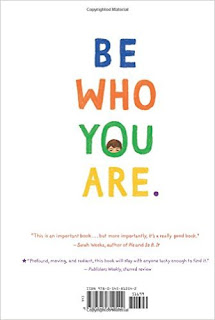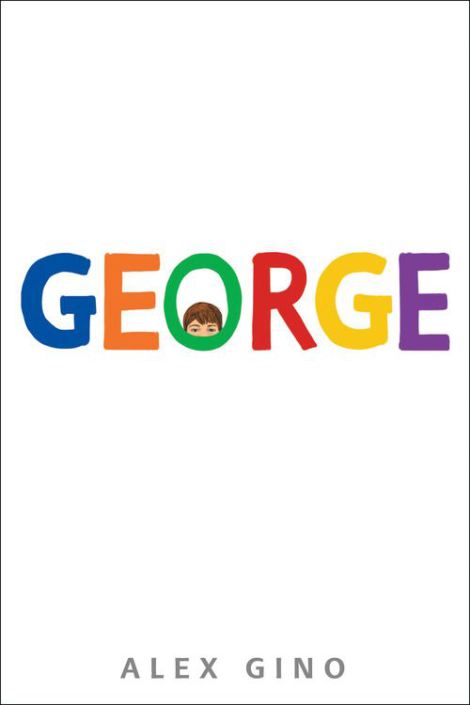 George by Alex Gino is a groundbreaking, vitally important, perfectly written addition to the shelves of children's literature. George is the story of ten-year-old George Mitchell who knows she is a girl, in spite of physical appearances. Over the course of the story, George struggles with what she knows to be true and wanting to tell the people in her life this truth. I came to George, after reading laudatory reviews and interviews, expecting a novel with the character development, layering and emotional power of RJ Palacio's Wonder and found myself initially disappointed. George is a quiet story, told simply. As I read into the story, I realized that, in their (Gino prefers to use the singular pronoun "they") writing style, Gino had transported me into the mind of a ten-year-old. George doesn't know everything that I know (which is not much, admittedly) about gender in the 21st century. George does not know what I know about sexuality, either. And in this, Gino has hit the exact right tone in their novel. There are but two age appropriate references to romantic feelings for another person George fleetingly, vaguely considers. There is a very off the page suggestion of (the word is never used) masturbation and the brief mention of porno, both by George's teenaged brother Scott near the end of the novel. And, once George is able to tell her mother and brother that she is a girl, she is asked if she is gay. Most kids are exposed to more references to sex and sexuality in the media they consume on a daily bases, be it television, movies and games, than they will be when they read George.
George by Alex Gino is a groundbreaking, vitally important, perfectly written addition to the shelves of children's literature. George is the story of ten-year-old George Mitchell who knows she is a girl, in spite of physical appearances. Over the course of the story, George struggles with what she knows to be true and wanting to tell the people in her life this truth. I came to George, after reading laudatory reviews and interviews, expecting a novel with the character development, layering and emotional power of RJ Palacio's Wonder and found myself initially disappointed. George is a quiet story, told simply. As I read into the story, I realized that, in their (Gino prefers to use the singular pronoun "they") writing style, Gino had transported me into the mind of a ten-year-old. George doesn't know everything that I know (which is not much, admittedly) about gender in the 21st century. George does not know what I know about sexuality, either. And in this, Gino has hit the exact right tone in their novel. There are but two age appropriate references to romantic feelings for another person George fleetingly, vaguely considers. There is a very off the page suggestion of (the word is never used) masturbation and the brief mention of porno, both by George's teenaged brother Scott near the end of the novel. And, once George is able to tell her mother and brother that she is a girl, she is asked if she is gay. Most kids are exposed to more references to sex and sexuality in the media they consume on a daily bases, be it television, movies and games, than they will be when they read George.
Throughout George the narrator refers to George as "her." This is subtly jarring at first, but a few chapters in and it feels as natural to the reader as it must to George herself. Once you are comfortable with this, you realize that George using the pronouns she finds appropriate with herself is not enough. Like the pronouns she uses, George has to hide everything about herself, from the teen life/fashion magazines she hides in a denim purse under a huge pile of stuffed animals in her closet to the horrible way she feels when she is called "Mr. Mitchell," young man or little boy. As the story unfolds, the weight of George's secret internal life builds and reaches a breaking point with auditions for the fourth grade production of Charlotte's Web. Already teased for crying in class as their teacher read the final words of Charlotte the spider, George is scared to admit that she wants to try out for the part of Charlotte. George's audition goes badly, and here, as an adult I found myself a bit surprised by the backwards response of the teacher to her wish to play Charlotte. At the same time, I realized that this is important to the story and young readers need to know that there are closed minded adult or just plain unexperienced adults who would handle a boy wanting to play the role of a girl badly.
George is taunted by the school bully and his sidekick and supported by her best friend Kelly, who gets the part of Charlotte. Not understanding George's emotions initially but accepting of her best friend nonetheless, Kelly becomes the first person George tells that she identifies as a girl. Gino layers other adults with varying perspectives and responses into the story, from George's single mother, who struggles with George's identity, worrying about the difficulties her child will face, to the traditional-thinking teacher Ms. Udell to Principal Maldonado who, George discovers when she is in her office for being involved in a fight, has a poster of a rainbow flag that reads, "SUPPORT SAFE SPACES FOR GAY, LESBIAN, BISEXUAL, AND TRANSGENDER YOUTH." And, after George tells her mother and brother that she is a girl, she and Kelly find a way for her to get to play Charlotte in the school play after all. Gino makes clear that just the act of telling those you are close to is not always a dramatic game changer, it is a first step down a long path that will have ups and downs.
In an interview with Kase Wickman, they talked about why young readers really need trans narratives. After starting her article with a great quote from Nora Ephron about the value of literature, Wickman notes that reading "can not only bring beauty and reality and imagination, it can also provide us with essential instruction on how to live." Gino confirms this by sharing a story from their childhood. After reading a "Babysitters Club Little Sisters" book where the main character finds words written on the chalkboard blurry and eventually ends up getting glasses, Gino realized that the chalkboard was blurry for them, too, and ended up getting an eye exam. George is sure to reach other young readers in this way, in the way that Judy Blume demystified menstruation and scoliosis for girls of my generation some 35+ years ago. Gino ends George on a hopeful but tentative note as she gets to wear the clothes she has longed to wear, comb her hair forward and be called Melissa when she accompanies Kelly and her Uncle to the Bronx Zoo, far enough away that no one they know will be there. While I loved the scene where Melissa asks Kelly for some girl's underwear and Kelly tells her that she doesn't have to take her skirt off to change. And I also cried a little when Melissa and Kelly head into the girl's restroom. But, my favorite moment came when Kelly, who is a budding photographer and was constantly asking George to pose for her, giving instructions, takes pictures of Melissa. Gino writes, "Kelly didn't ask Melissa to pose once. She didn't have to. Melissa already looked perfect in every one."
Speaking to the end of his novel, Gino also says, "I wanted to make sure that I didn't leave people with an 'it gets better in the future' feel, because that's not enough. It has to be now. Sometimes the results when you reveal yourself don't go well, and sometimes they do, and when they do it can be from the people you least expect." This is embodied perfectly in George, from the immediacy of the story to the varied and surprising reactions. I want to end this review with another quote from Gino that is fitting here. In the interview, Gino says, "This is only one trans story. This is not the only trans story. And I really look forward to more diverse trans stories and more intersectional trans stories. Trans stories where being trans is only part of it. Trans stories about people of color, people with disabilities, people who don't speak English as their first language, and also have a trans narrative." If George, as an early example of what hopefully is a growing genre in children's literature, is any indicator, we have a lot of wonderful books ahead of us!
Source: Purchased

No comments:
Post a Comment